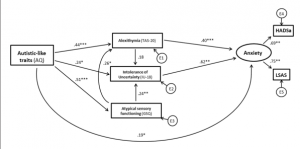Examining a model of anxiety in autistic adults
Saskia Riedelbauch, Sebastian B Gaigg, Tobias Thiel, Veit Roessner and Melanie Ring
Abstract
Anxiety disorders commonly occur in autism. Existing studies implicate intolerance of uncertainty, alexithymia, sensory processing differences and emotion regulation difficulties as influencing factors of anxiety in autism. To date, a few studies have considered the combination of these factors within the same sample. This study used structural equation modelling to test the prediction that intolerance of uncertainty and emotion regulation constitute more direct causes of anxiety in autism that mediate the influences of sensory processing difference and alexithymia as more sequential contributing factors. Autistic (n=86) and non-autistic adults (n=100) completed a battery of self-report questionnaires. Only when applied to each group separately, the broad predictions of the model were confirmed for the autistic group following data-driven additions of paths between sensory processing difference and anxiety and alexithymia implying that sensory processing difference contribute indirectly as well as directly to individual differences in anxiety. For the non-autistic group, model fit could only be achieved after removing autism-related traits and sensory processing differences as predictors of anxiety. These results suggest that aetiology and expression of anxiety in autism partially overlap with what is observed in the general population except that sensory processing differences appear to play a relatively unique role in the context of autism.
孤独症患者常有焦虑。现有研究表明,不确定性不耐受、述情障碍、感觉加工差异和情绪调节困难是孤独症焦虑的影响因素。迄今为止,一些研究考虑了同一样本中这些因素的组合。这项研究使用结构方程模型来测试对不确定性的不容忍和情绪调节构成自闭症焦虑的更直接原因的预测,这些因素介导了感觉加工差异和述情障碍作为更连续的影响因素的影响。孤独症患者(86人)和非孤独症患者(100人)完成了一系列自我报告问卷。只有当分别应用于每一组时,该模型的广泛预测才在自闭症组中得到证实,这是因为数据驱动了感觉处理差异与焦虑和述情障碍之间的路径的增加,这表明感觉处理差异间接和直接导致了焦虑的个体差异。对于非孤独症组,模型拟合只能在去除与孤独症相关的特质和感觉处理差异作为焦虑的预测因素后才能实现。这些结果表明,孤独症的病因和焦虑表现与在普通人群中观察到的部分重叠,只是感觉加工差异似乎在孤独症的背景下发挥了相对独特的作用。
Lay abstract
Anxiety disorders are common in autism. Research studies have identified factors that influence anxiety in autism, such as difficulties with uncertain situations, difficulties understanding own emotions, differences in processing sensory input (related to our senses) and difficulties regulating emotions. To date, a few studies have considered the combination of these factors within the same sample. This study used structural equation modelling to test the contribution of these factors in autism. Autistic (n=86) and non-autistic adults (n=100) completed a battery of self-report questionnaires.
Only when applied to each group separately, the broad predictions of the model were confirmed for the autistic group. The model confirmed that difficulties with uncertain situations and in regulating emotions play a central role in anxiety in autism. Difficulties understanding own emotions and differences in processing sensory input both contribute to anxiety indirectly through their respective interrelation with the other two factors (difficulties with uncertain situations and in regulating emotions). Importantly, the results imply that sensory processing differences contribute not only indirectly but also directly to individual differences in anxiety. For the non-autistic group, model fit could only be achieved after removing autism-related traits and sensory processing differences as predictors of anxiety. These results suggest that cause/development and expression of anxiety in autism partially overlap with what is observed in the general population except that sensory processing differences appear to play a relatively unique role in the context of autism.
焦虑在孤独症群体中很常见。研究已经确定了影响孤独症患者焦虑的因素,例如不确定情况下的困难、理解自己情绪的困难、处理感官输入(与我们的感官有关)的差异以及调节情绪的困难。迄今为止,一些研究考虑了同一样本中这些因素的组合。这项研究使用结构方程模型来测试这些因素在孤独症中的作用。孤独症患者(86人)和非自闭症患者(100人)完成了一系列自我报告问卷。只有当分别应用于每个群体时,该模型的广泛预测才在自闭症群体中得到证实。该模型证实,在不确定的情况下和调节情绪方面的困难在孤独症患者的焦虑中起着核心作用。理解自己情绪的困难和处理感觉输入的差异都通过它们与其他两个因素(不确定情况和调节情绪的困难)的相互关系间接导致焦虑。重要的是,研究结果表明感觉加工差异不仅间接而且直接导致了焦虑的个体差异。对于非孤独症组,模型拟合只能在去除与孤独症相关的特质和感觉处理差异作为焦虑的预测因素后才能实现。这些结果表明,孤独症患者焦虑的原因/发展和表达与普通人群中观察到的部分重叠,只是感觉加工差异似乎在自闭症的背景下发挥了相对独特的作用。
图1:结构方程建模结果(孤独症群体)

图2:结构方程建模结果(非孤独症群体)

